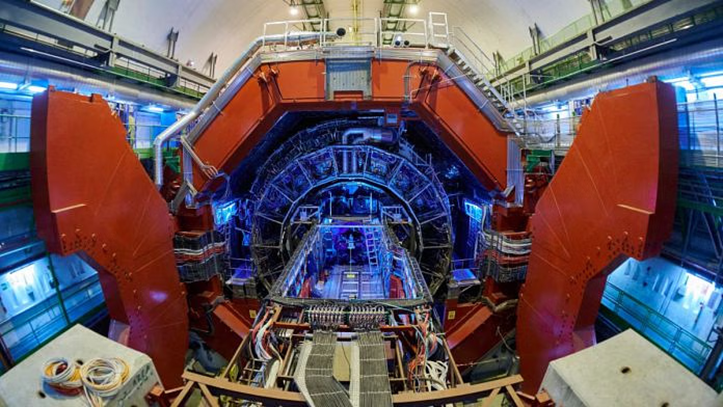- On May 8, 2025, scientists at CERN (European Organization for Nuclear Research) officially announced that the Large Hadron Collider (LHC) had successfully converted lead into gold at a nuclear level.
- This is the 1st time that gold has been created from another element using controlled, high-energy nuclear physics experiments.
- Although the amount of gold created was extremely small—measured in trillionths of a gram.
- It would take millions of years of such collisions to produce even one gram of gold.
- Therefore, the process has no commercial or industrial value.
- And the atoms existed for only a tiny fraction of a second, the achievement has significant scientific importance.
- It confirms the possibility of nuclear transmutation, something that alchemists had dreamed of for centuries but could never achieve.
Historical Background: The Alchemical Dream
- The concept of chrysopoeia means turning base metals like lead into gold. This originated with alchemists in the Middle Ages.
- They believed that since lead and gold looked similar in some ways and had similar densities. So, it might be possible to transform one into the other.
- However, with the development of modern chemistry and atomic theory, scientists realized that such a transformation was impossible through chemical means because each element has a fixed number of protons in its nucleus.
- Modern physics, especially nuclear physics, has changed that understanding.
- By changing the number of protons and neutrons in the nucleus of an atom, one element can indeed be turned into another.
- This process is called nuclear transmutation and is what scientists at CERN have now shown with lead and gold.
How the Transformation Happened at CERN
- The transformation of lead into gold occurred during high-speed collisions inside the Large Hadron Collider (LHC).
- In these experiments, scientists used lead nuclei (Pb-208) and accelerated them to 99.999993% of the speed of light.
- These lead nuclei were then made to pass very close to each other without touching. This is a process known as an ultra-peripheral collision.
- During such near-miss collisions, the powerful electric fields of the fast-moving lead nuclei generated intense electromagnetic forces.
- These forces emitted high-energy virtual photons, which hit the lead nucleus and knocked out some of its particles.
- Specifically, when a lead nucleus lost 3 protons and 2 neutrons, it transformed into a gold nucleus, specifically gold-203 (Au-203).
- This process is called electromagnetic dissociation, and it is a type of nuclear reaction caused by electromagnetic forces rather than physical collisions.
The Role of the ALICE Detector and Zero Degree Calorimeters (ZDCs)
- The detection and analysis of gold production were made possible by the ALICE (A Large Ion Collider Experiment) detector, which is one of the 4 main detectors at the LHC.
- ALICE is designed to study heavy ion collisions and the behavior of matter under extreme conditions.
- Within the ALICE detector, a set of instruments called Zero Degree Calorimeters (ZDCs) played a critical role.
- These are specialized tools that detect and measure particles traveling close to the beamline with almost zero angle.
- The ZDCs recorded the number of protons and neutrons ejected during the electromagnetic dissociation process.
- By observing which particles were ejected, scientists were able to determine which new element was formed.
- For example:
- The loss of 1 proton from lead resulted in the creation of thallium.
- The loss of 2 protons led to mercury.
- The loss of 3 protons and 2 neutrons resulted in the creation of gold (Au-203).
About the Large Hadron Collider (LHC)
- The Large Hadron Collider (LHC) is the world’s most powerful particle accelerator.
- It was built by CERN to explore the fundamental particles and forces that make up the universe.
- Key facts about the LHC:
- It is located underground near Geneva, along the France–Switzerland border.
- The LHC is a 27-kilometre-long circular tunnel equipped with superconducting magnets and advanced particle detectors.
- It can accelerate particles—such as protons and lead ions—to speeds of over 99.999999% the speed of light.
- The LHC includes four main detectors: ALICE, ATLAS, CMS, and LHCb, each designed to study different aspects of particle physics.
- The LHC is famous for the 2012 discovery of the Higgs Boson, also known as the “God particle,” which explains how particles get their mass.
About CERN

- CERN stands for the European Organization for Nuclear Research.
- It is one of the world’s largest and most respected centers for scientific research in the field of particle physics.
- Important facts about CERN:
- CERN was established in 1954, after World War II, as Europe’s first joint scientific venture.
- It is headquartered in Geneva, Switzerland.
- CERN has 23 member states and 10 associate members, including India.
- CERN’s primary goal is to explore the basic structure of the universe using high-energy physics experiments.
- It operates the LHC and various cutting-edge experiments involving fundamental particles




